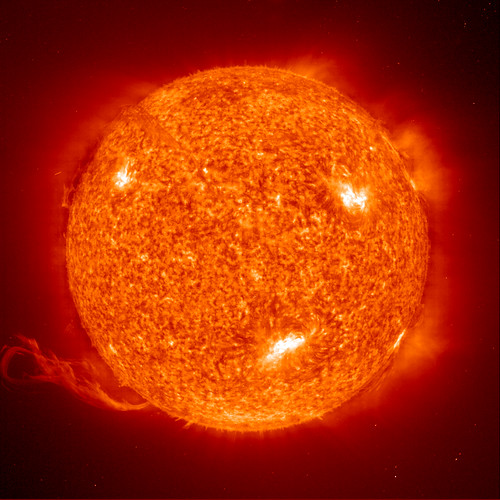If you’ve been staring at the Sun lately, then you may have noticed it looks a wee bit bigger today than it did a few days ago. That’s not because the UV light from the Sun is frying your retina; it’s actually true. Today is perihelion, the time when the Earth is closest to the Sun in its orbit.
 |
Sitting here on this whirling blob of mud, we actually go around the Sun in an ellipse, not a circle. It’s almost a circle, though. The deviation of an ellipse from perfect circelness is called the eccentricity, and runs from 0 (a true circle) to 1 (which would actually be a parabola, kind of like a circle stretched out infinitely to one side). The formula for eccentricity is pretty simple:
 |
The a in the equation is the semimajor axis of the ellipse, or half the long dimension. b is the semiminor axis — half the short width. For a circle, a = b, so the equation works out to 0 as it should. As the ellipse gets more oval, a gets bigger and b gets smaller, and the eccentricity approaches the value of 1.
For the Earth’s orbit, the eccentricity is a miniscule 0.0167, meaning that a and b are pretty close to being the same value. The semimajor axis of the Earth is about 149,598,000 kilometers (93 million miles). Using the value of the eccentricity and plugging it into the equation, the semiminor axis of the Earth is about 149,577,000 km.
So you might think that the Earth gets as far as 149,598,000 km from the Sun, and as close as 149,577,000, a difference of about 21,000 kilometers (13,000 miles). But that’s not correct!
That would be true if the Sun sat at the center of the Earth’s orbital ellipse. It doesn’t. Ellipses are funny when you’re talking gravity and orbits; the more massive object (the Sun) sits at the focus of the less massive object’s (the Earth’s) elliptical orbit. The focus is not really the center, it’s offset from the center by the distance (a2 - b2)1/2. Here’s our diagram again with the focus labeled:
 |
Plugging and chugging in our values for a and b, we get the Sun being 2.5 million km (1.6 million miles) from the center of the Earth’s orbit. That means the farthest we can get from the Sun is the semimajor axis a plus the distance of the focus from the center: 149,598,000 + 2,500,000 = (roughly) 152,000,000 km (94.4 million miles).
The closest we can get is the semimajor axis minus the focus distance = 149,598,000 - 2,500,000 = (roughly) 147,000,000 km (91.3 million miles). Note I’m not trying to be hugely accurate here; I just want an idea of these numbers.
So over the course of the year, the Earth ranges from about 147 million km from the Sun at its closest to about 152 million km, a difference of about 5 million km (3 million miles), or a difference of a little over 3%.
When the Earth is precisely at the point in its orbit closest to the Sun, that’s perihelion. That happened today, January 4, 2009 at 15:00 UT (10:00 a.m. Eastern time). Aphelion, when we’re farthest away, won’t be until July 4.
What does this mean? Well, that translates directly into a 3% change in the apparent size of the Sun in the sky over the year. Honestly? You’d never notice, staring at the Sun or not. You’d need a telescope and careful measurements to see the difference.
Temperature? In fact, yeah, when we’re at perihelion the Earth gets a little more light and heat from the Sun, and less at aphelion. Yet here in the northern hemisphere we’re in the dead of winter. Obviously, the distance of the Earth from the Sun doesn’t affect the seasons very much. Why not? Well, that’s a whole ‘nuther story.
But for now, enjoy our solar proximity. Over the next six months we’ll pull away from our nearest star, and then in July we’ll reach the apex of our orbit, and the dance starts all over again.



No comments:
Post a Comment